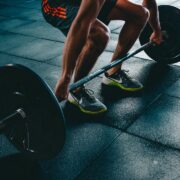
Effective Bodyweight Exercises for Toned Muscles
Bodyweight exercises are a form of strength training that uses the weight of your own body as resistance. These exercises require no equipment and can be done anywhere, making them a convenient and cost-effective way to stay fit. The history of bodyweight exercises dates back centuries, with ancient civilizations using them as a means of training for battle and physical challenges. Today, bodyweight exercises are an integral part of fitness routines, helping individuals improve their strength, flexibility, and overall fitness level.
Key Takeaways
- Bodyweight exercises are exercises that use your own body weight as resistance.
- Benefits of bodyweight exercises include improved strength, flexibility, and balance, as well as convenience and cost-effectiveness.
- The top 5 bodyweight exercises for toning muscles are squats, lunges, push-ups, planks, and dips.
- To perform push-ups for maximum results, focus on proper form and engage your core muscles.
- Squats and lunges are the ultimate leg toning exercises, while planks and crunches strengthen your core and dips and pull-ups build upper body strength.
Benefits of Bodyweight Exercises
One of the main benefits of bodyweight exercises is that they are cost-effective. Unlike gym memberships or expensive equipment, bodyweight exercises require no financial investment. All you need is your own body and a little bit of space to perform these exercises. This makes them accessible to everyone, regardless of their financial situation.
Another advantage of bodyweight exercises is that they can be done anywhere. Whether you’re at home, in a park, or traveling, you can always find a space to do a quick workout. This eliminates the need for a gym or specialized equipment, making it easier to stay consistent with your fitness routine.
In addition to being cost-effective and convenient, bodyweight exercises also offer numerous physical benefits. They improve balance and flexibility by engaging multiple muscle groups at once. This helps to strengthen the stabilizer muscles in your body, which are responsible for maintaining balance and preventing injuries.
Bodyweight exercises also build functional strength, which is the ability to perform everyday tasks with ease. By using your own body weight as resistance, you are training your muscles to work together in a coordinated manner. This translates into improved performance in activities such as lifting heavy objects, climbing stairs, or carrying groceries.
Furthermore, bodyweight exercises reduce the risk of injury compared to traditional weightlifting exercises. Since you are not using external weights or machines, there is less strain on your joints and connective tissues. This makes bodyweight exercises a safer option for individuals with joint issues or previous injuries.
Top 5 Bodyweight Exercises for Toning Muscles
1. Squats: Squats are a compound exercise that targets multiple muscle groups, including the quadriceps, hamstrings, glutes, and core. To perform a squat, stand with your feet shoulder-width apart and lower your body down as if you were sitting back into a chair. Keep your chest up and your weight in your heels. Push through your heels to return to the starting position.
2. Push-ups: Push-ups are a classic bodyweight exercise that primarily targets the chest, shoulders, and triceps. Start in a plank position with your hands slightly wider than shoulder-width apart. Lower your body down by bending your elbows, keeping them close to your sides. Push back up to the starting position.
3. Lunges: Lunges are another effective exercise for toning the lower body, particularly the quadriceps, hamstrings, and glutes. Start by standing with your feet hip-width apart. Take a step forward with one foot and lower your body down until both knees are at a 90-degree angle. Push through your front heel to return to the starting position and repeat on the other side.
4. Planks: Planks are an excellent exercise for strengthening the core muscles, including the abdominals, obliques, and lower back. Start in a push-up position with your hands directly under your shoulders and your body in a straight line from head to toe. Hold this position for as long as you can while maintaining proper form.
5. Dips: Dips target the triceps, chest, and shoulders. To perform a dip, find two parallel bars or use the edge of a sturdy chair or bench. Place your hands on the bars or edge with your palms facing down and lower your body down by bending your elbows. Push back up to the starting position.
How to Perform Push-Ups for Maximum Results
| Push-Up Variation | Muscles Targeted | Difficulty Level | Repetitions | Rest Time |
|---|---|---|---|---|
| Standard Push-Up | Chest, Triceps, Shoulders, Core | Beginner | 3 sets of 10-15 reps | 30-60 seconds |
| Wide Push-Up | Chest, Shoulders, Triceps | Intermediate | 3 sets of 10-15 reps | 30-60 seconds |
| Diamond Push-Up | Triceps, Chest, Shoulders | Advanced | 3 sets of 8-12 reps | 60-90 seconds |
| Decline Push-Up | Upper Chest, Shoulders, Triceps | Intermediate | 3 sets of 10-15 reps | 30-60 seconds |
| Incline Push-Up | Lower Chest, Shoulders, Triceps | Beginner | 3 sets of 10-15 reps | 30-60 seconds |
Push-ups are a versatile exercise that can be modified to target different muscle groups and increase the intensity of the workout. To perform a basic push-up, start in a plank position with your hands slightly wider than shoulder-width apart. Lower your body down by bending your elbows, keeping them close to your sides. Push back up to the starting position.
To target the chest muscles more, you can place your hands wider than shoulder-width apart. This will increase the range of motion and engage the chest muscles to a greater extent.
To target the triceps more, you can place your hands closer together, forming a diamond shape with your thumbs and index fingers. This will shift the focus from the chest to the triceps.
To increase the intensity of the push-up, you can elevate your feet on a bench or step. This will engage the shoulders and upper chest muscles more.
Common mistakes to avoid when performing push-ups include sagging or arching the lower back, allowing the elbows to flare out to the sides, and not lowering the body down far enough. It’s important to maintain a straight line from head to toe throughout the movement and to lower the body until the elbows are at a 90-degree angle.
Squats and Lunges: The Ultimate Leg Toning Exercises
Squats and lunges are two of the most effective exercises for toning and strengthening the lower body. They target multiple muscle groups, including the quadriceps, hamstrings, glutes, and calves.
To perform a squat, stand with your feet shoulder-width apart and lower your body down as if you were sitting back into a chair. Keep your chest up and your weight in your heels. Push through your heels to return to the starting position.
To perform a lunge, start by standing with your feet hip-width apart. Take a step forward with one foot and lower your body down until both knees are at a 90-degree angle. Push through your front heel to return to the starting position and repeat on the other side.
Variations of squats include sumo squats, where you take a wider stance and point your toes outwards, and jump squats, where you explode up from the squat position and land softly back into the squat.
Variations of lunges include reverse lunges, where you step back instead of forward, and walking lunges, where you take alternating steps forward.
Common mistakes to avoid when performing squats and lunges include allowing the knees to cave inwards, leaning too far forward, and not going low enough. It’s important to keep your knees in line with your toes, maintain an upright posture, and lower your body down until both knees are at a 90-degree angle.
Planks and Crunches: Strengthening Your Core
Planks and crunches are two exercises that specifically target the core muscles, including the abdominals, obliques, and lower back.
To perform a plank, start in a push-up position with your hands directly under your shoulders and your body in a straight line from head to toe. Hold this position for as long as you can while maintaining proper form. To increase the intensity of the plank, you can lift one leg or one arm off the ground.
To perform a crunch, lie on your back with your knees bent and feet flat on the ground. Place your hands behind your head or across your chest. Engage your core muscles and lift your upper body off the ground, curling towards your knees. Lower back down with control and repeat.
Variations of planks include side planks, where you balance on one forearm and stack your feet on top of each other, and plank jacks, where you jump your feet out and in while maintaining the plank position.
Variations of crunches include bicycle crunches, where you alternate bringing one knee towards the opposite elbow, and reverse crunches, where you lift your hips off the ground and bring your knees towards your chest.
Common mistakes to avoid when performing planks and crunches include sagging or arching the lower back, using momentum to lift the upper body, and not engaging the core muscles. It’s important to maintain a straight line from head to toe in planks and to focus on using the abdominal muscles to lift the upper body in crunches.
Dips and Pull-Ups: Building Upper Body Strength
Dips and pull-ups are two exercises that target the muscles of the upper body, including the chest, shoulders, back, and arms.
To perform a dip, find two parallel bars or use the edge of a sturdy chair or bench. Place your hands on the bars or edge with your palms facing down and lower your body down by bending your elbows. Push back up to the starting position.
To perform a pull-up, find a horizontal bar that is high enough for you to hang from with your arms fully extended. Grip the bar with your palms facing away from you and hands slightly wider than shoulder-width apart. Pull your body up towards the bar by engaging your back muscles. Lower back down with control and repeat.
Variations of dips include bench dips, where you place your hands on a bench behind you and lower your body down by bending your elbows, and tricep dips, where you keep your elbows close to your sides as you lower down.
Variations of pull-ups include chin-ups, where you grip the bar with your palms facing towards you, and assisted pull-ups, where you use a resistance band or machine to assist with the movement.
Common mistakes to avoid when performing dips and pull-ups include not fully extending the arms at the bottom of the movement, using momentum to complete the exercise, and not engaging the correct muscles. It’s important to maintain proper form and focus on using the targeted muscles to perform the exercise.
Tips for Proper Form and Technique
Proper form and technique are crucial when performing bodyweight exercises to maximize results and prevent injuries. Here are some tips to help you maintain proper form:
– Keep your core engaged: Engaging your core muscles throughout the exercises will help stabilize your body and protect your lower back.
– Maintain a neutral spine: Avoid arching or rounding your back during exercises. Keep your spine in a neutral position to prevent strain on your back.
– Focus on the targeted muscles: Concentrate on using the muscles you are targeting during each exercise. This will ensure that you are getting the most out of each movement.
– Breathe properly: Remember to breathe throughout each exercise. Inhale during the eccentric phase (lowering or lengthening) and exhale during the concentric phase (lifting or shortening).
– Start with proper progressions: If you are new to bodyweight exercises or have any physical limitations, start with easier variations of each exercise and gradually progress to more challenging ones.
Common mistakes to avoid when performing bodyweight exercises include using momentum to complete the movement, sacrificing form for quantity, and not engaging the correct muscles. It’s important to focus on quality over quantity and to listen to your body’s limitations.
Creating a Bodyweight Exercise Routine
Designing a bodyweight exercise routine involves considering your fitness goals, current fitness level, and time availability. Here are some factors to consider when designing a routine:
– Choose exercises that target all major muscle groups: Include exercises that target the upper body, lower body, and core to ensure a balanced workout.
– Vary the intensity: Incorporate both high-intensity exercises that challenge your cardiovascular system and low-intensity exercises that focus on strength and endurance.
– Include both compound and isolation exercises: Compound exercises, such as squats and push-ups, target multiple muscle groups at once, while isolation exercises, such as crunches and tricep dips, target specific muscles.
– Allow for rest and recovery: Make sure to include rest days in your routine to allow your muscles to recover and prevent overtraining.
A sample bodyweight exercise routine could include:
– Squats: 3 sets of 12 reps
– Push-ups: 3 sets of 10 reps
– Lunges: 3 sets of 12 reps (each leg)
– Planks: 3 sets of 30 seconds
– Dips: 3 sets of 10 reps
Perform this routine two to three times per week, allowing at least one day of rest in between workouts. As you become stronger and more comfortable with the exercises, you can increase the number of sets or reps, or progress to more challenging variations.
Achieving Toned Muscles with Bodyweight Exercises
In conclusion, bodyweight exercises are a cost-effective and convenient way to stay fit and tone your muscles. They offer numerous benefits, including improved balance and flexibility, functional strength, and reduced risk of injury. By incorporating exercises such as squats, push-ups, lunges, planks, and dips into your fitness routine, you can target all major muscle groups and achieve a toned physique.
Remember to focus on proper form and technique when performing bodyweight exercises to maximize results and prevent injuries. Start with easier variations of each exercise and gradually progress to more challenging ones as you become stronger. Design a bodyweight exercise routine that suits your fitness goals, current fitness level, and time availability.
Incorporating bodyweight exercises into your fitness routine will not only help you achieve toned muscles but also improve your overall fitness level and enhance your quality of life. So, grab a mat and get started on your bodyweight exercise journey today!
FAQs
What are bodyweight exercises?
Bodyweight exercises are exercises that use the weight of your own body as resistance to build strength and muscle.
What are the benefits of bodyweight exercises?
Bodyweight exercises can be done anywhere, require no equipment, and can be modified to fit any fitness level. They also improve balance, flexibility, and overall body control.
Can bodyweight exercises help with muscle toning?
Yes, bodyweight exercises can help with muscle toning by targeting specific muscle groups and increasing muscle endurance.
What are some examples of bodyweight exercises for muscle toning?
Examples of bodyweight exercises for muscle toning include push-ups, squats, lunges, planks, and burpees.
How often should I do bodyweight exercises for muscle toning?
It is recommended to do bodyweight exercises for muscle toning at least 2-3 times per week, with a rest day in between each session.
Can bodyweight exercises be combined with other forms of exercise?
Yes, bodyweight exercises can be combined with other forms of exercise such as cardio or weightlifting to create a well-rounded fitness routine.


















